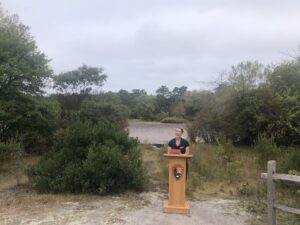PROVINCETOWN — Nearly two dozen tree enthusiasts, some with binoculars slung around their necks, others carrying walking sticks, hovered around the head of the Beech Forest trail on the morning of Oct 6. Birders congregated at one wooden picnic table, while another was filled with National Seashore volunteers. All were there to celebrate the inauguration of the National Seashore’s Beech Forest into the Old-Growth Forest Network, a consortium recognizing protected forests around the country.
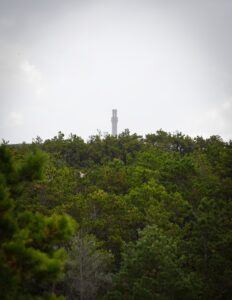
Sarah Robb Grieco, the Northeast regional director of the Network, arrived to present the Park with a plaque about a foot tall with an image of a gnarled tree, honoring the Beech Forest.
The Network’s aim is to care for and extend the lives of forests like this one. Among the six forests Grieco inaugurates annually, this one holds special significance, she said. As a kid, she used to visit Cape Cod with her “big Italian family.” She loved the Beech Forest back then, even though she had no idea it was an old-growth forest or what the term even meant.
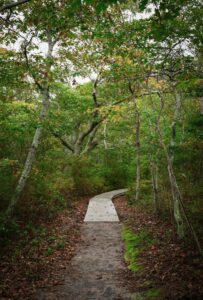
The honor is an attempt to affirm the Park’s promise to preserve and protect this forest. “It’s a feather in their cap,” Grieco said. Though it doesn’t provide any material support, “It’s prestigious to be part of this network.”
In simple terms, an old-growth forest is one that has never been logged. But the title is debated among ecologists who argue about whether the designation should be based on age, carbon absorption, or other factors. There is no argument about the Beech Forest, though: it is paradigmatic old-growth at the ripe age of 600. It is much older than forests in nearby Plymouth and Nantucket that belong to the Network but are described as “future old-growths” if properly cared for.
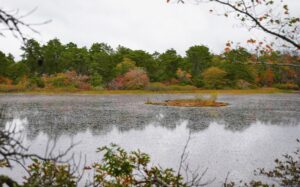
The Beech Forest is a vestige of the past, thick with yellow- and green-leafed beeches mixed with oaks and maples. Some sassafras peeks out of the undergrowth, and a wide array of migratory birds — tree swallows, cedar waxwings, snow buntings — perch in the branches. The forest gives a sense of what the dunes of the National Seashore looked like before they were deforested and the topsoil drifted away without any vegetation to root it down, according to National Seashore plant ecologist Stephen Smith.
But the beeches don’t look quite the same as they did 600 years ago. Their leaves are dry and dying, some burnished with dark marks, as beech leaf disease spreads across the forest.
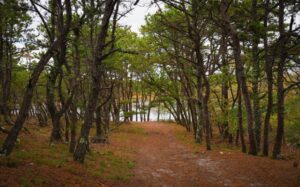
First found on Cape Cod two years ago, the disease appears to be caused by bird-borne nematodes. The treatments that exist can be implemented only one tree at a time, Supervisory Park Ranger Aleutia Scott said. For a forest full of beeches, there is no large-scale solution. Even if helicopters flew over the Beech Forest and sprayed pesticides to kill the nematodes, Smith said, migratory birds would arrive and bring more.
Smith tries to look at the upside: “When the beech trees eventually succumb to this disease, they will be replaced by other native species — red maples and oaks and black gums,” Smith said. Those trees have been living in the forest for a long time. In his estimation, most of the beech trees will be gone in five years, depending on growing conditions. The drier the season, the less resilient the beeches are to disease. Ultimately, he said, the loss of the beeches “is really not in our control. We have to accept the change.”
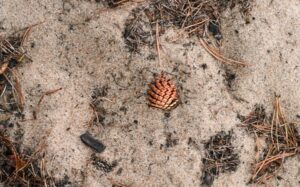
What about the fact that the forest is named after the beeches? Well, the beeches make up only 5 to 7 percent of the Beech Forest to begin with, Smith said. Most of the trees are pines and oaks. It’s an interesting question, he said, one that he hasn’t got an exact answer for. “Maybe there is some value in keeping that name and educating people on what happened in the past,” he said.
But the day’s event was about celebrating the Beech Forest in the present, not its troubled future. It began with a prayer of gratitude from Toodie Coombs, a member of the Mashpee Wampanoag tribe, whose ancestors populated these forests seasonally before the Mayflower sailed into Provincetown Harbor. According to the Network’s site, “the amount of old-growth forest has declined every year since European settlement on this continent.”
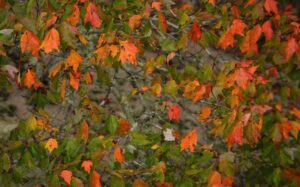
Coombs spoke first in Wampanoag and then in English. “We share the same struggles today,” she said, referring to her tribe and to non-Wampanoag caretakers of the park. We share a responsibility for our children, she added, “to make sure that they come up the way we did” – that is, close to nature. Tears rose in Coombs’s eyes as she thanked the audience for caring for the Beech Forest. Beneath the brims of their hats, a couple of the park rangers also shed a few tears.
